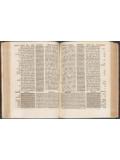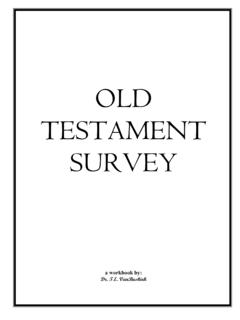Transcription of INTRODUCTION TO THE PENTATEUCH
1 INTRODUCTION TO THE PENTATEUCH . By Davies Professor of old testament , University of Cambridge From Chapter 3 of The Oxford Bible Commentary edited by John Barton and John Muddiman (Oxford University Press, 2013). chapter-3. What is the PENTATEUCH ? The name PENTATEUCH ' means literally the work comprising five scrolls', from Greek pente and teukhos, which can mean scroll'. It has been used since at least early Christian times for the first five books of the OT, Genesis to Deuteronomy. The Jewish name for these books was usually and still is the law': Hebrew t r , Greek nomos or nomothesia (the latter is literally legislation'), and it is this name which appears in the NT: Lk 24:11 , What is written in the law, the prophets and the psalms', where we meet the threefold subdivision of the Hebrew canon that continues to be used, with the substitution of writings' for psalms' as the third section.
2 Cf. also the Greek Prologue to Sirach ( BCE). But there is a much deeper way of asking, and answering, the question, What is the PENTATEUCH ?', one which goes beyond merely defining its external limits to enquire into its nature. In other words, what sort of a thing is this section of the Bible? This question can only really be answered after a full examination of the text, and one justification for the kind of detailed critical analysis which has been popular in modern OT scholarship is that it enables us to give a well-judged (if complicated!)
3 Answer to that question. It is a question of considerable theological importance, as can be seen from an introductory look at a few answers that have been given to it, some of which will be examined more fully later on. Four of the five books in the PENTATEUCH deal with the time of Moses, and one recent suggestion has been that we should think of the PENTATEUCH as a biography of Moses with an INTRODUCTION , that is, Genesis. This attempts to answer the question in terms of the literary genre of the PENTATEUCH . Its main weakness, however, is that it puts Moses as an individual too much in the centre of the picture, important as he undoubtedly is as the leader of his people Israel.
4 We might do better to call the PENTATEUCH the story of Israel in the time of Moses, with an INTRODUCTION (Genesis) which sets it in the light of universal creation and history. To many, however, this would not be theological enough to do justice to the strongly religious element that pervades the story from beginning to end. Gerhard von Rad suggested that the PENTATEUCH (or to be more precise, the Hexateuch, that is the PENTATEUCH plus the sixth book of the Bible, Joshua see below) was an amplified creed, more specifically an amplified historical 1.
5 Creed, as will be seen in more detail later. The implication is then that the PENTATEUCH is a product and an expression of faith it is preceded as it were by an implicit I believe in God who ', it is a confessional document, as one might put it. Of course the adjective historical' before creed'. raises some problems, for example whether the story which the PENTATEUCH as a whole tells is real history, a question whose answer has important theological implications which critics of von Rad were quick to point out. But there are also problems of a simpler kind which relate specifically to its accuracy as a description of Genesis 1 11.
6 Von Rad was, for much of his scholarly career, fascinated by the historical focus of so much of Israel's faith, and he tended to overlook or play down its teaching about God the Creator. This may well have been due to an understandable wish on his part not to allow a foothold in the OT for crude Nazi ideas about racial supremacy grounded in the order of creation which were current at the time he wrote his earliest works on the Hexateuch. It is, nevertheless, necessary to emphasize that the beginning of Genesis is not about history in the ordinary sense of that word, or indeed in any sense, and the idea that the PENTATEUCH is a historical' creed is in danger of losing sight of the important theological statements about creation in those chapters.
7 A different way of representing the theological character of the PENTATEUCH is of course the traditional Jewish expression: the law. This is as characteristic of Judaism as von Rad's emphasis on faith is characteristic of his Lutheranism. If it seems at first sight to focus too much on the second half of the PENTATEUCH , where the laws are concentrated, and to give insufficient attention to the story' character of the earlier books, it is worth saying that this problem has not escaped the notice of Jewish commentators, and a very early one, Philo of Alexandria, in the first century CE, had what he thought was a perfectly satisfactory answer to it.
8 It is that while written law is indeed mainly found in the later books of the PENTATEUCH , the personalities who appear in Genesis, for example, constitute a kind of living law', since through their example, and in some less obvious ways, it was God's intention to regulate human behaviour, just as he does later by the written law. Another way of making the description law' more widely applicable involves going back to the Hebrew term t r . Although commonly translated law', its original meaning is something like instruction', and it could be used of other kinds of instruction as well as law in the strict sense.
9 For example, the word t r is found in Proverbs, where the context shows that the reference is to the kind of teaching contained there, not to the law as such. If we use t r as a description for the PENTATEUCH in this more general sense of teaching' or instruction', it can easily embrace the non-legal parts of these books as well as the legal ones. On the other hand, while t r understood in this wider way does preserve an important truth about the PENTATEUCH (especially if it is thought of as The Teaching', with a capital T), it is in danger of being too vague a description to identify its distinctive character within the OT.
10 Another theological definition, which has the merit of combining the advantages of the last two, is to call the PENTATEUCH a covenant book, a document which presents the terms of God's relationship to his people, in the form of his promises to them and the laws which he requires them to obey. The support of the apostle Paul can probably be claimed for this description, for when he speaks of the old covenant' in 2 Cor 3:14 it is very likely that he means specifically the PENTATEUCH . He is clearly thinking of a written document, because he refers to the reading' of the old covenant, and the substitution of the expression whenever Moses is read' in the following verse points firmly to the PENTATEUCH (for Moses' as shorthand for the books of Moses' see Lk 24:27 ).



